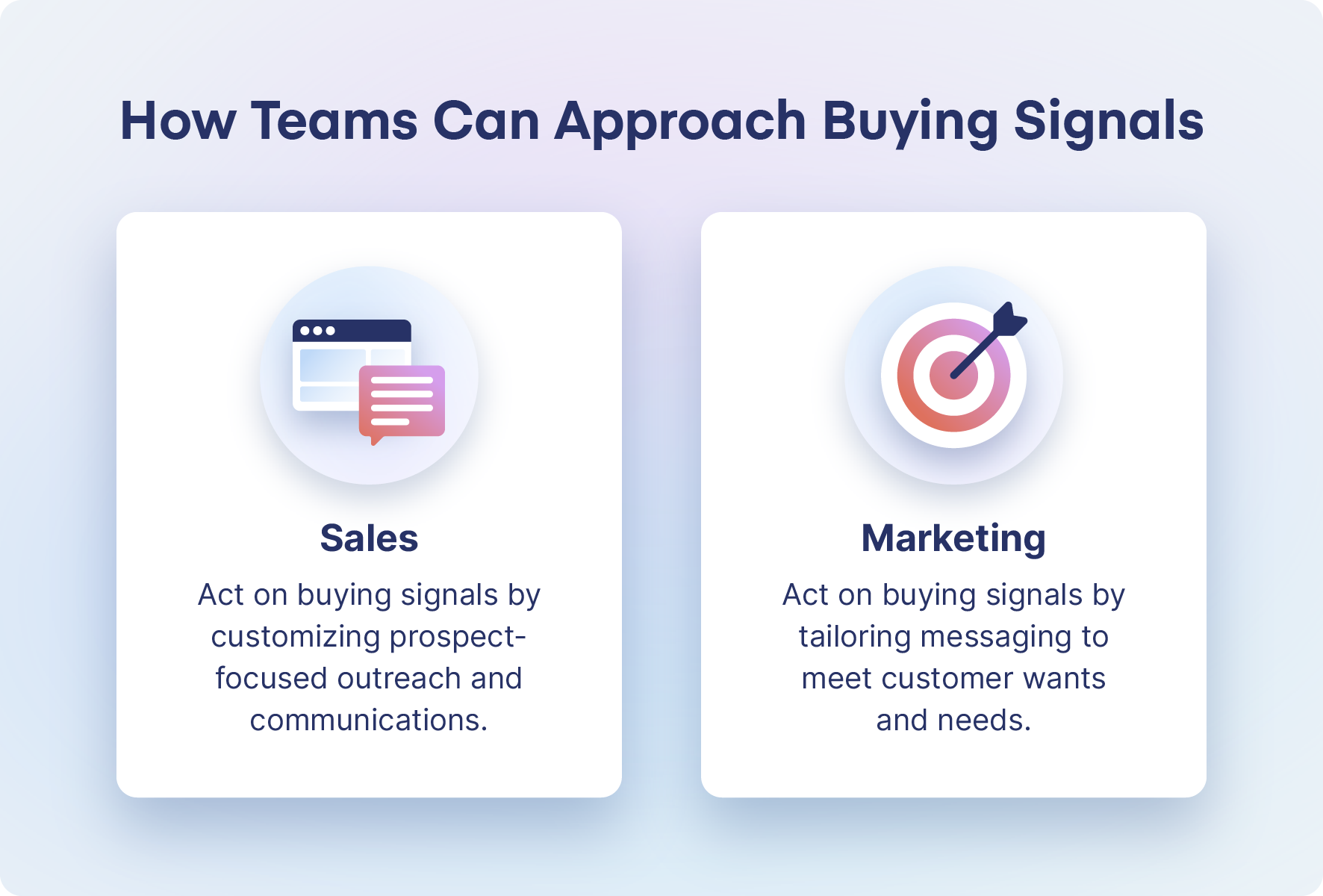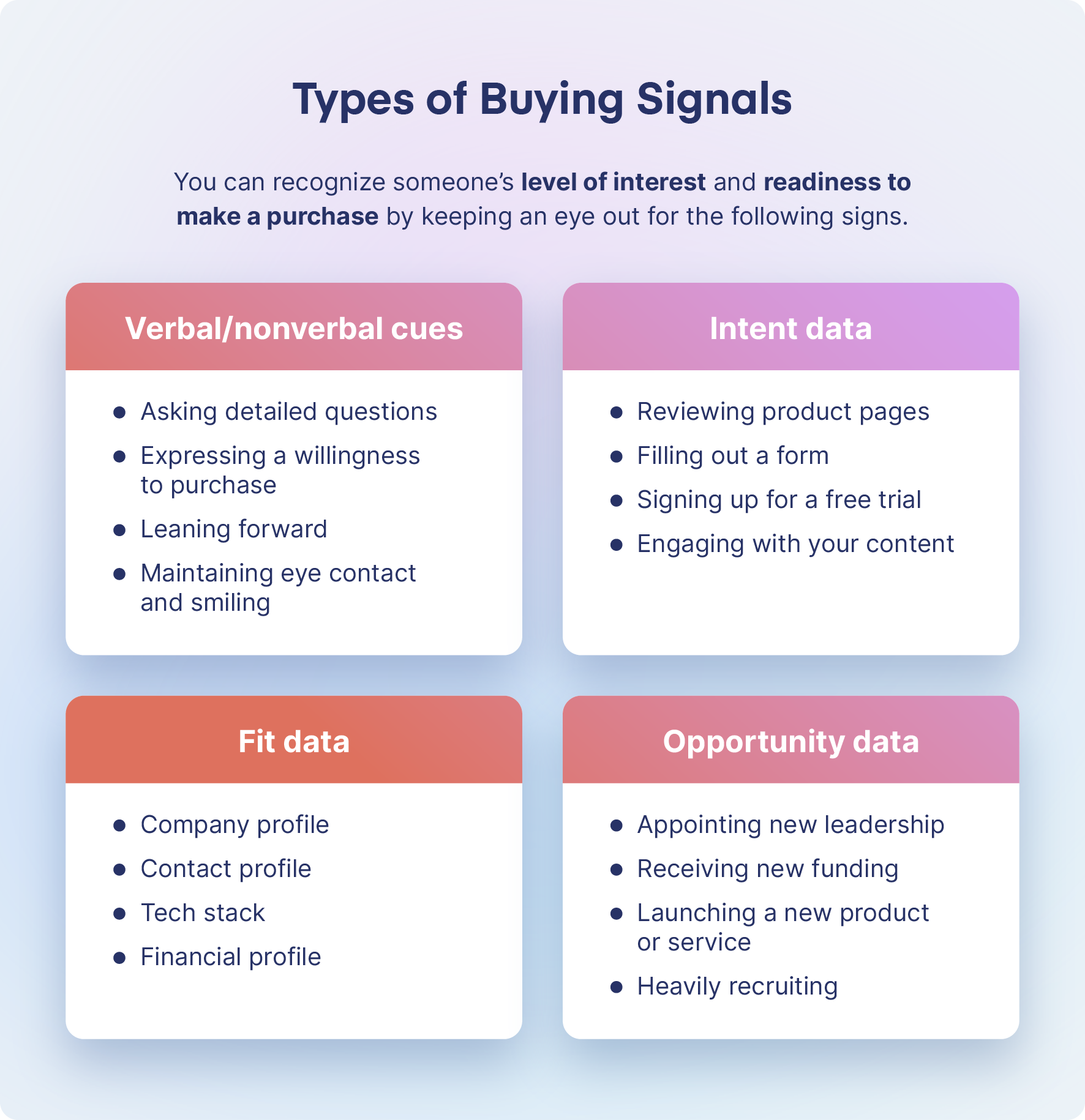Buying signals: Definition + 15 examples
Buying signals are an essential aspect of the sales and marketing process. Identifying these signs can help businesses understand when a potential customer is ready to make a purchase.
However, spotting buying signals isn't always easy, and it may require a keen eye and strategic approach to convert these prospects into paying customers.
In this post, we’ll explore what buying signals are and how to spot them, plus 15 examples so businesses can effectively identify and respond to these cues to drive successful sales outcomes.
What are buying signals?
Buying signals are a potential customer's actions or behaviors that suggest an interest in buying a product or service. These signals can take many forms, from verbal cues like asking questions that indicate a desire or need for a product to online behaviors like signing up for a free trial.
Understanding and responding to buying signals is a crucial component of successful sales and marketing, as it helps qualify and pre-qualify leads and streamlines the buying process.
By identifying and addressing customer needs and interests, businesses can also build strong relationships with their customers, increase sales, and ultimately drive long-term growth.
Buying signals in sales vs. marketing
Your sales and marketing teams must have a solid understanding of how to take advantage of buying signals, as they’re essential to their success. Understanding buying signals will help sales teams better follow up on leads, and marketing teams will be able to target their content to the needs and desires of prospective customers.

Buying signals in sales
Buying signals in sales means your sales team needs to be able to identify, respond to, and act on these signs at the right time. Sales reps are seven times more likely to have meaningful conversations with decision-makers when they reach out within an hour of detecting a buying signal.
For example, if someone is doing research on your company on review sites, this indicates a high purchase intent. As a seller, recognizing this buying signal can provide an opportunity to engage with the person and provide additional information or insights that may be helpful in their decision-making process.
By recognizing and addressing a potential customer's needs or desires, salespeople can build trust and establish a positive rapport, ultimately increasing the likelihood of a successful sale.
Buying signals in marketing
Buying signals in marketing are important for showing prospective customers the right content at the perfect time. In fact, forty-seven percent of buyers look at three to five pieces of a company's content before speaking with a salesperson. Your marketing team must understand how to take advantage of these opportunities by delivering content that is both timely and relevant.
For instance, if someone visits a company's website and spends a good amount of time on a specific product page, this could indicate a strong level of interest in that product. Marketers can then produce targeted ads or email campaigns that share more information about the product the customer has been viewing.
By analyzing patterns in buying signals, marketers can gain insights into customer preferences and behaviors, allowing them to tailor their messaging to better meet customer needs and desires.
How to recognize buying signals
Buying signals can take many forms, whether it’s through communication or online activity. Let’s walk through the main types of buying signals to look out for.

Verbal and nonverbal cues
Verbal and nonverbal cues refer to the communication signals a potential customer provides during an interaction, which can indicate their level of interest and readiness to make a purchase.
Verbal buying signals may include expressing interest in a product or service, asking detailed questions about its features or benefits, or making statements that show a willingness to move forward with a purchase.
Nonverbal buying signals, on the other hand, are communicated through body language, facial expressions, and other nonverbal signals. For example, a potential customer may lean forward in their seat, maintain eye contact, nod their head, or smile, all of which can show interest and engagement.
Intent data
Intent data provides insights into a potential customer's online behavior and activity, indicating their level of interest and likelihood to make a purchase. Intent data can be used as a buying signal to identify potential customers who are actively researching and considering a purchase.
For example, intent data may include information about a person's search history, indicating that they have been researching a particular product or service. This could suggest a strong level of interest and a higher likelihood of making a purchase.
Fit data
Fit data describes firmographic and demographic data used to see if a prospect matches the profile of an ideal customer. Fit data can be used as a buying signal to determine whether a potential customer is a good fit for a company's products or services.
For instance, if a company specializes in providing IT services to small businesses, fit data such as company size and industry could indicate a strong potential customer match. Similarly, if a company offers high-end luxury products, fit data like income level could be used to identify potential customers who are most likely to be interested in and able to afford the products.
However, just because a prospect is a fit doesn't mean they want to buy from you. That’s why you should use this data in conjunction with intent data to further refine marketing and sales efforts.
Opportunity data
Opportunity data refers to information that signifies a potential customer's likelihood to make a purchase based on specific events or circumstances. For B2B companies, this might include favorable circumstances within an organization that demonstrate ideal conditions for a sale.
For example, if a prospective company had a recent successful funding round, it could signify a larger budget, meaning they may be more likely to welcome new business and not have as many budget constraints.
Opportunity data might also include information about a potential customer's recent change in leadership, indicating a potential increase in buying power and a higher likelihood of making a purchase.
15 examples of buying signals
From verbal cues to digital interactions, buying signals can come in various forms. Let’s explore 15 examples of buying signals businesses should be aware of.

1. Engaging with your content
Signal indicator: Low
Engaging with content, such as sharing a company’s social media post or liking or commenting on a blog post, is considered a buying signal because it suggests the prospect has at least some level of interest in your offerings.
However, interactions with some pieces of content, such as funny Twitter memes, wouldn’t be considered a strong buying signal. Examples include commenting on your company’s blog posts with questions or positive feedback or sharing your new product launch announcement from socials with a colleague.
Pro tip: Use Clearbit data to power your favorite personalization tool to show the ideal content, headline, and call to action for converting anonymous visitors to paying customers.
2. Downloading gated content
Signal indicator: Low
Gated content refers to any content that is only accessible after a person provides their contact information or completes a form, such as a book or white paper. When someone downloads gated content, it suggests that they’re interested in learning more about your product or service and are willing to exchange their information for more details.
These prospects are more promising than occasional blog readers, so reaching out to them to learn more about what they're looking for may help move them further down the sales funnel.
Pro tip: To incentivize downloads of your gated content, offer a preview or a limited-time offer.
3. Appointing new leadership at their company
Signal indicator: Low
Appointing new leadership at a company can be considered a buying signal because it suggests that the company may be undergoing changes and potentially seeking new solutions or partnerships to address new goals or challenges.
When a new leader is appointed, they may have different priorities and preferences for the company's direction, which could open up new opportunities for vendors or service providers.
Pro tip: You should first build a relationship with the new leader and demonstrate how your offering can support the company's goals, positioning yourself as a trusted partner and increasing the likelihood of a successful sale.
4. Earning a successful funding round at their company
Signal indicator: Low
Earning a successful funding round at a company can be considered a buying signal because it indicates that the company has secured the necessary resources to pursue its goals and expand its operations.
When a company receives funding, it may be in a stronger position to invest in new products or services, expand its customer base, or explore new markets. This also demonstrates that the company has a strong vision and strategy for growth, which could make it more open to considering new solutions or partnerships.
Pro tip: Focus on understanding the company's goals and priorities so you can position your product as a valuable resource that can help the company achieve its objectives.
5. Showing interest in a specific product or service
Signal indicator: Medium
Showing interest in a specific product or service is considered a buying signal because it indicates that a potential customer has done their research and is clear on what they want. A prospect's interest can be expressed through a sales consultation or intent data such as frequent visits to a product page. By doing so, they show active consideration of your offering as a solution to their pain points.
This buying signal is particularly valuable because it suggests that the prospect is more likely to be receptive to further communication and outreach from your company regarding the product or service. It also provides an opportunity for you to tailor your outreach to the specific needs of the prospect, increasing the likelihood of conversion.
Pro tip: Capitalize on prospects visiting a website with timely and personalized outreach based on their behavior using Clearbit’s intent-based outreach solution.
6. Disclosing their pain points
Signal indicator: Medium
If a prospect discloses their pain points, they’re essentially giving the seller information about what they’re looking for and what’s important to them. This is a good sign, as it shows that there’s some level of urgency to find a solution, and they’re open to exploring your solution further.
This can help you tailor your approach and messaging to better resonate with the buyer's needs and interests. It can also help you position your product or service as the solution the buyer needs to overcome their challenges.
Pro tip: Some buyers may not even realize they have a problem, so ensure you conduct thorough research to showcase how your offering would be a great benefit to them.
7. Researching on review sites
Signal indicator: Medium
By visiting product profiles and comparisons on review sites, prospects are indicating purchase intent. They’re likely looking for unbiased opinions and experiences from other customers to inform their purchasing decision, making it a valuable buying signal to act on.
This may also suggest that the person is further along in the buying process and has already identified potential solutions to consider. They’re probably looking for specific information to help them make a final decision or to validate their preliminary research.
Pro tip: Tools like Clearbit and G2's integration allow you to access G2 Buyer Intent signals in Clearbit, which can be combined with fit data and website intent data to identify high-intent prospects.
8. Involving their peers for opinions
Signal indicator: Medium
When a potential customer involves their peers in a conversation, it may indicate that they are internally discussing how your offering aligns with their needs. This is a good buying signal, as it indicates they’re weighing out the pros and cons and may be close to making a final decision.
Did a prospect copy their colleagues during email communication with your sales team? Did you notice that more than one person from a company is visiting your site? Either way, involving other people in the buying process is a good sign that they’re strongly considering your solution.
Pro tip: Use Clearbit Reveal to uncover the companies behind anonymous website visits to know when target accounts demonstrate buying intent.
9. Showing interest in case studies
Signal indicator: Medium
When a prospect shows interest in case studies, it suggests that they’re in the consideration phase of the sales funnel and are looking for social proof that others have had success with your product. Case studies are valuable tools in this process and can help build confidence in their decision to purchase.
Whether a prospect asks you directly for success stories or you find that they’re looking at case studies on your website, the fact that they’re looking for evidence is a great buying signal.
Pro tip: Handle case study inquiries sensitively and professionally by focusing on the buyer's needs and providing studies that are relevant to the prospect’s experience.
10. Responding positively to cold outreach
Signal indicator: Medium
Cold outreach has been the bane of many salespeople’s existence, as there are not always positive responses to their efforts. However, when a prospect does respond positively to a cold call or email, it’s a great sign that their interest has piqued, and they genuinely want to learn more about the solution.
A positive response to cold outreach also indicates that they’re open to new solutions and may be actively seeking ways to improve their business or address specific needs or pain points.
Pro tip: Rather than pushing for a sale too aggressively, focus on building relationships with potential customers and taking a consultative approach that prioritizes the person's needs.
11. Signing up for a free trial
Signal indicator: High
Signing up for a free trial is a valuable buying signal because it shows that a potential customer is interested enough in a product or service that they're willing to check it out themselves. This provides an opportunity for companies to showcase their offerings and potentially convert those trial users into paying customers.
However, not all free trial sign-ups lead to purchases, and some users may just be testing it out. Nevertheless, free trial sign-ups remain an effective way for sales and marketing teams to engage with potential customers and convert them into paying customers.
Pro tip: To help nurture free trial users, consider engaging them with helpful tips and tutorials on how to use the product effectively.
12. Filling out a form
Signal indicator: High
Filling out a form is another great buying signal, as it signifies a potential customer's willingness to provide personal information in exchange for more information about the product. This provides companies with valuable information for follow-up communication and outreach, indicating the potential customer is actively considering the product or service and may be receptive to further communication.
The level of commitment and engagement required to fill out a form, particularly if it’s lengthy or requires significant information, may suggest a higher likelihood of conversion into a paying customer. However, if the process takes too long, you risk missing out on valuable opportunities, so make sure your forms aren’t too extensive.
Pro tip: Make it easy for your prospective customers to fill out a form with Clearbit’s form optimization tool.
13. Asking about pricing
Signal indicator: High
If a prospect asks about pricing, it shows they have some level of interest and are considering whether the offering is within their budget or worth the investment. This provides an opportunity for the seller to engage in a conversation and potentially move the prospect further along in the buying process.
By answering the question, you can provide more information about the product or service, highlight its value proposition, and address any concerns or objections the buyer may have. This can help build trust and establish a relationship with the buyer, making them more likely to make a purchase.
Pro tip: Instead of simply providing a number, try to understand the prospect's needs and provide a customized solution that aligns with their budget.
14. Inquiring about terms and conditions
Signal indicator: High
By asking about terms and conditions, the buyer is showing that they’re not only interested in the product or service itself, but also the details of the transaction, such as payment terms, delivery expectations, warranties, and other important considerations.
It suggests that the buyer is serious about making a purchase and wants to ensure they fully understand what they’re agreeing to before committing.
Pro tip: Build trust with the buyer by providing clear and concise information about the terms and conditions, showing your commitment to transparency and communication with customers.
15. Inquiring about next steps
Signal indicator: High
Normally, salespeople are responsible for planning the next steps in the sales process to ensure a smooth transition. However, if the prospect is initiating the conversation about next steps, it indicates their genuine interest and readiness to progress toward a sale.
If you detect the prospect's eagerness to move forward, it may be possible to expedite the selling process and proceed directly to presenting a proposal, potentially bypassing some steps.
Pro tip: Be proactive in following up on next steps and communicate clearly and promptly with the prospect to avoid any delays or confusion.
Find and close more deals with Clearbit
Buying signals are important indicators that a prospect is ready to move forward with a purchase decision. Whether you're in sales or marketing, recognizing these behaviors will help you position yourself as a trusted partner and increase your chances of success.
At Clearbit, we build products focused on helping you identify these buying signals so you can capture leads promptly and accurately.

